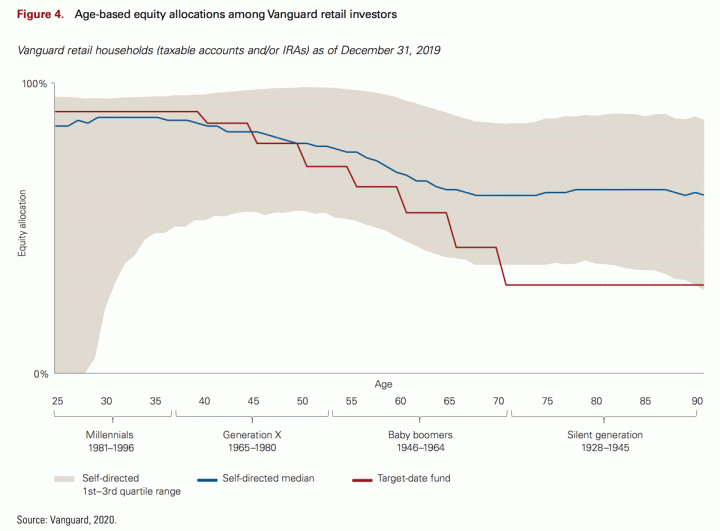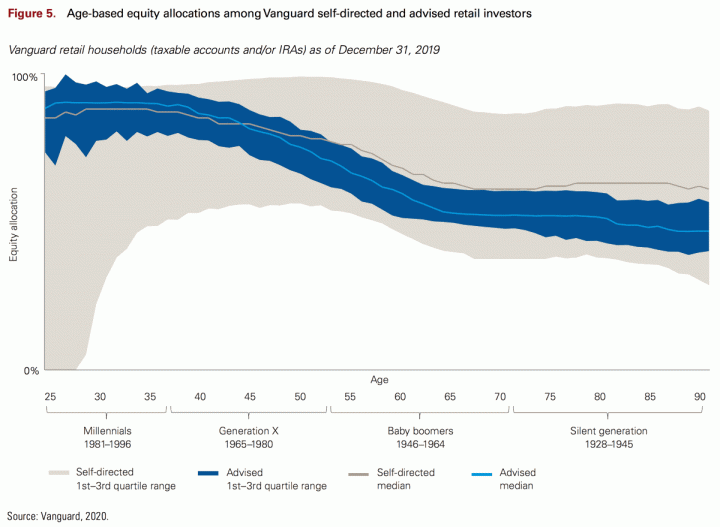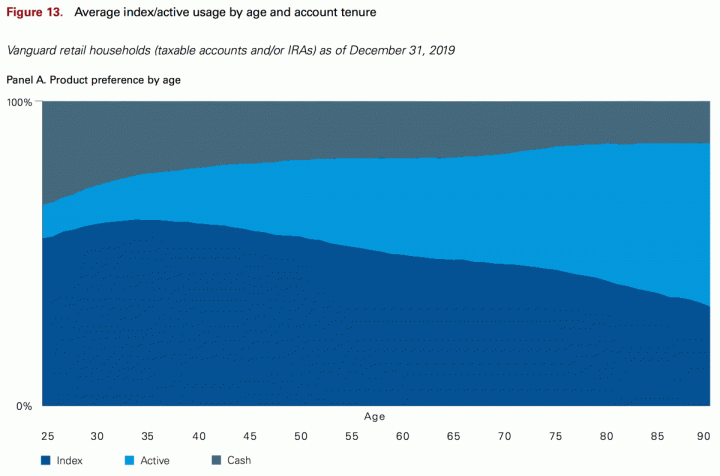
Vanguard recently released a report on “How America Invests”, based on the 5 million households with Vanguard retail accounts (taxable and IRAs, not 401ks). It looked at investor behavior from 2015 through 2019, along with the first quarter of 2020, when there was a sharp market decline due to the COVID-19 pandemic. There is a lot of information packed inside, but here are a few quick takeaways.
The average portfolio of a Vanguard household. The averages seem reasonable, but I was a bit surprised that 16% of households are 100% bonds. Even if I was extremely conservative, I would still own something like 20% stocks to hedge against the risk of inflation and rising rates.
The typical Vanguard household holds a long-term, risk-taking portfolio that’s both diversified and balanced. The average portfolio consists of 63% equities (stocks), 16% fixed income (bonds), and 21% cash (short-term reserves). However, there are substantial differences in risk-taking across investors, with equity risk ranging from conservative to aggressive for investors with otherwise similar asset levels or ages. At the extremes, 16% of households hold no equities, while 22% hold very risky portfolios containing at least 98% equities.
Self-directed investor glide path vs. what Vanguard thinks is best. It is interesting to see what people actually own when they are self-directed, as compared to what Vanguard recommends in their Target-date Retirement Fund and their Vanguard Personal Advisory Services (VPAS) that charges an 0.30% annual fee.
This chart compares the asset allocation (% in stocks) of self-directed investors (blue line is median) against that of Vanguard target-date funds (red line). We see that there is a lot of variation amongst self-directed investors, but overall they do decrease their exposure over time like nearly all target-date funds. However, they don’t decrease it nearly as much as Vanguard’s target-date funds past the age of 65. (Click to enlarge.)
This chart compares the asset allocation (% in stocks) of self-directed investors (dark beige is median) against that of those being advised by Vanguard Personal Advisory Services (light blue line is median). Here, the recommended median asset allocation is much closer to that of the self-directed median. Comparing with the chart above, we see a gap betwewn VPAS and their own Target Retirement funds. Why are their target-date funds so much more conservative? (Click to enlarge.)
Mutual funds are still the most popular, but ETFs are gaining. Only 13% of Vanguard households hold any ETFs at all as of 2019, but that number is double that of 2015.
Younger investors tend to own index funds, while older investors still hold a lot of actively-managed funds. This chart tracks the usage of index funds/actively-managed funds/cash vs. age. I’m actually a little surprised at how much actively-managed funds are held by the older cohorts. Contrast this with the fact that roughly 2/3rd of Vanguard’s global assets under management are in their index funds/ETFs. (Click to enlarge.)
Vanguard account owners are not active traders! Over 75% of Vanguard households place zero trades per year. The Vanguard stereotype would probably be the polar opposite of the Robinhood stereotype. (As someone with the majority of their assets at Vanguard and only a small percentage in trading apps, I’m quite fine with that!) Check out this quote (emphasis mine):
Fewer than one-quarter of Vanguard households trade in any given year, and those that do typically only trade twice. Most traders’ behavior is consistent with rebalancing or is professionally advised.
During the COVID-19 market volatility, Vanguard households stayed boring and long-term focused. The quote below essentially says “they did nothing different”.
Twenty-two percent of households traded in the first half of 2020—a rate typical of trading for a full calendar year. Despite the increase in trading, less than 1% of households abandoned equities completely during the downturn, while just over 1% traded to extremely aggressive portfolios. The net result of the portfolio and market changes was a modest reduction in the average household equity allocation, from 63% to 62%.



 The Best Credit Card Bonus Offers – 2025
The Best Credit Card Bonus Offers – 2025 Big List of Free Stocks from Brokerage Apps
Big List of Free Stocks from Brokerage Apps Best Interest Rates on Cash - 2025
Best Interest Rates on Cash - 2025 Free Credit Scores x 3 + Free Credit Monitoring
Free Credit Scores x 3 + Free Credit Monitoring Best No Fee 0% APR Balance Transfer Offers
Best No Fee 0% APR Balance Transfer Offers Little-Known Cellular Data Plans That Can Save Big Money
Little-Known Cellular Data Plans That Can Save Big Money How To Haggle Your Cable or Direct TV Bill
How To Haggle Your Cable or Direct TV Bill Big List of Free Consumer Data Reports (Credit, Rent, Work)
Big List of Free Consumer Data Reports (Credit, Rent, Work)
Thanks Jonathan, this is all interesting.
However, whenever I see a study published by a mutual fund company of users’ asset allocation, I’m left thinking, “But they don’t really know the entire story!” My workplace accounts are at Fidelity and my Roth IRA is at Vanguard. If they are only counting my Vanguard portion as my entire portfolio, then I’m included in that “very risky” 22%, because I focus my bonds in a tax-deferred account outside of Vanguard. My overall portfolio is 70% equity and 30% fixed income, so I’m really not in that group.
The reverse situation – someone with only tax-deferred accounts at Vanguard and a Roth elsewhere, might account for some of that 16% that’s showing up as only bonds.
I have to think having accounts at multiple brokerages is not rare, and these individual brokerage studies need to be taken with a gigantic mound of salt.
Dan, that was my first thought too. If it’s only tracking their Vanguard accounts, then that might explain the 16% who hold 100% bonds or even the 75% who place zero trades per year. People may hold many accounts across a variety of firms, with vastly different habits / risk tolerance / etc for each one.
That’s a good point. I wonder how much it tends to cancel out across big accounts, or maybe 401k vs IRA vs taxable account tend to be different on their own.
I think the reason target retirement is more conservative than what their advisors recommend for individual portfolios has to do with individual net worth. I would expect many of those using the advisory service to have relatively large portfolios and therefore can ride out a bear market while being aggressive on equities. For the target retirement being a catch-all comers plan, vanguard would have to account for those with smaller amounts saved for retirement and less ability to ride out a potential bear market. Therefore the need for a more conservative portfolio to help protect against significant market drops.
That’s a good observation as well.
The larger holding of actively-managed accounts by the older investors may be because they have larger taxable gains built up in those accounts, having held them longer, and they purchased those investments longer ago, before index funds were as popular. Thus these investors are not apt to trade these active funds and incur the tax on the large gain.
Another good observation. Even Bogle himself held a lot of Wellington and Wellesley for a long time due to the capital gains (and was sometimes criticized for it, unjustly in my opinion). I want to say that he later sold them primarily so he could create a better narrative around promoting index funds overall.